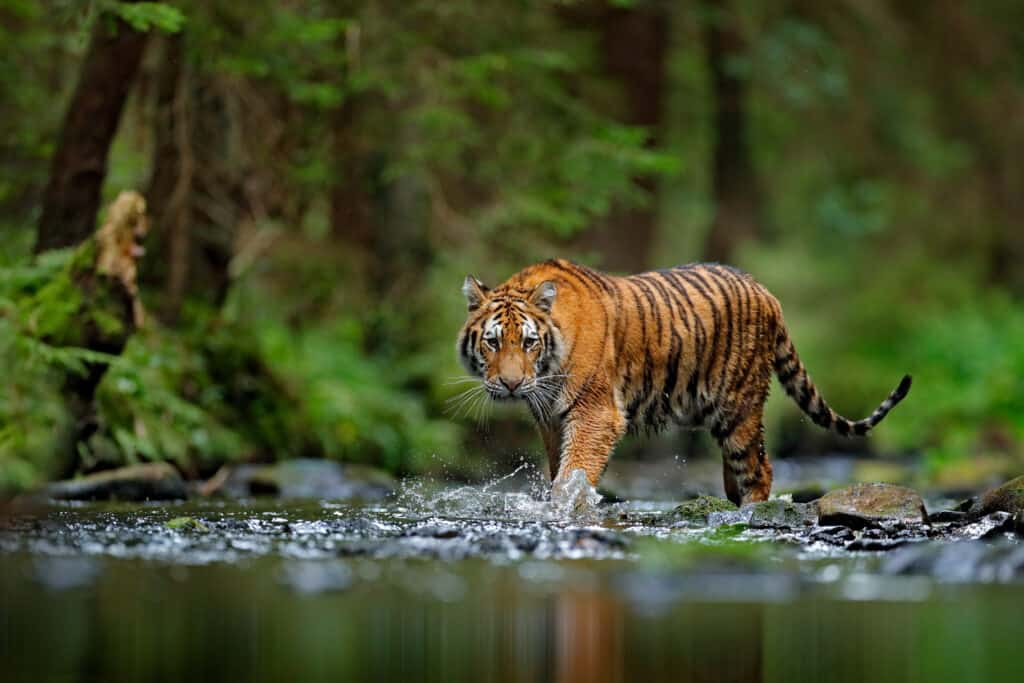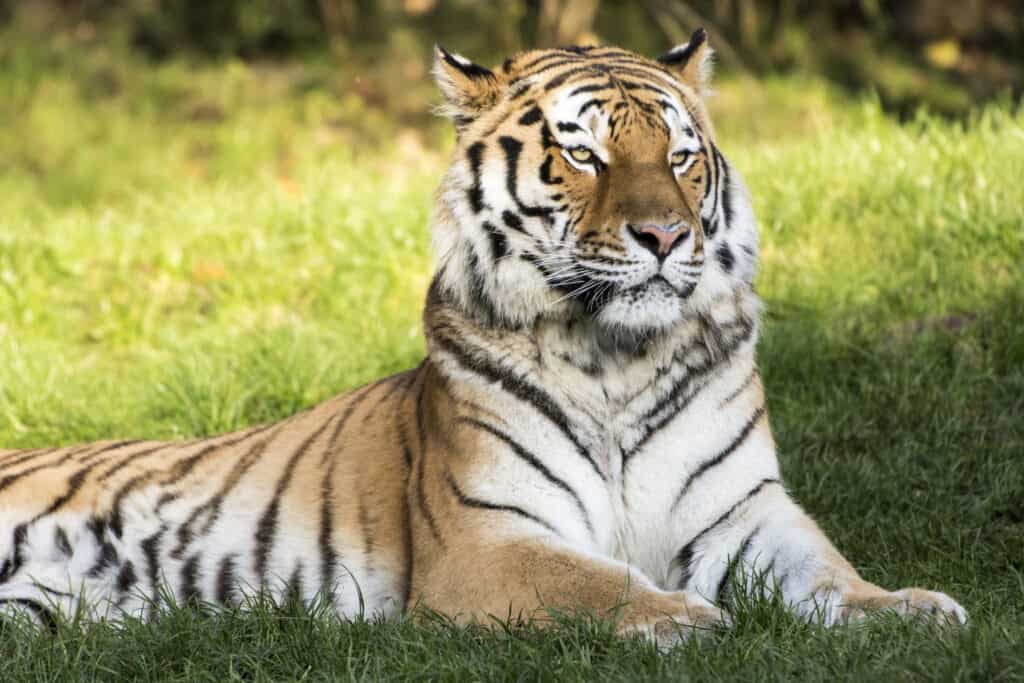At first glance, brown bears may look larger and heavier than tigers. On the other hand, tigers are fierce predators, and they often feed on large animals like bears, crocodiles, or leopards. But have they ever confronted brown bears? Let’s find out!
But first, let’s discuss some basic details about these two animals to get a general idea of how large and heavy they are.
What Are Tigers?

Tigers are considered apex predators in their habitats.
©iStock.com/Ondrej Prosicky
Tigers are the largest extant cat species known for their orange furs, white undersides, and dark vertical stripes. They’re considered apex predators in their habitats and prefer feeding on ungulates. Male tigers usually measure around 8.1 – 12.8 feet long and weigh up to 660 pounds, while females are much smaller and lighter, measuring 6.5 – 9 feet long and weighing up to 368 pounds.
Tigers are nocturnal predators but typically hunt during the day if they live in uninhabited areas. They ambush their prey, using their strength to unbalance it. They’re very fast, reaching up to 30–40 miles per hour. However, they cannot run fast for long distances, so they typically ambush prey from close distances. When they hunt large animals, they use their forelimbs to catch and hold onto the prey, bite its throat, and fight it to the ground.
What Are Brown Bears?

Brown bears eat almost anything they stumble upon but primarily rely on flowers, fruits, acorns, and mushrooms.
©Karin Jaehne/Shutterstock.com
Brown bears are large bears living in North America and Eurasia. At first sight, brown bears may look larger than tigers, mostly due to their thick fur. However, most measure around 4 – 9 feet long and weigh up to 400 pounds in males and 298 pounds in females. If we were to compare their size and weight with the average tiger size and weight, the orange cats are larger and heavier.
Brown bears aren’t considered active predators. They eat almost anything they stumble upon but primarily rely on flowers, fruits, acorns, and mushrooms. Some brown bears eat salmon. When they prey on other animals, brown bears often choose small prey and pin it to the ground, tearing and eating it alive. If they hunt large prey, which rarely happens, they hit the prey with their forearms, break its neck and back, and kill it.
Because they’re large and strong, brown bears can withstand confrontations with almost any predators. However, they take a step back in encounters with Siberian tigers. But let’s not rush things out; we’ll discuss this further in the article!
Where Do Tigers Kill Brown Bears?
Most brown bears are found in Russia, the United States, and Canada. Most tigers, on the other hand, are found in isolated regions in southern, southeastern, and eastern Asia. So, where do their paths cross? In Russia!
Siberian tigers live along the Primorsky Krai, meaning in Far East Russia, and extend into southern Khabarovsk Krai. Their population further extends within the Greater Xing’an Range.
So, naturally, brown bears and Siberian tigers may stumble upon each other in Eastern Russia.
Are Brown Bear vs. Siberian Tiger Confrontations Common?
Confrontations between brown bears and Siberian tigers are more common than you’d think. In fact, Siberian tigers actively hunt brown bears. Even brown bears sometimes seek out Siberian tigers to steal their kills. While both are large, strong predators, tigers are more skilled in killing brown bears. After all, that’s what they do daily. Brown bears, on the other hand, rarely hunt large prey and their hunting skills aren’t as developed. As we’ve mentioned, they’d rather follow the tracks of a Siberian tiger to steal its kill than confront it.
Of 44 recorded brown bear and Siberian tiger encounters, 20 resulted in fights. This indicates that neither likes the other. In half of these confrontations, brown bears were killed. In 27%, brown bears killed the tigers, and in 23%, there were no winners, and both survived.
Dr. John Goodrich, the Director of the Panthera Tiger Program, recollects how he “almost” saw a tiger kill a brown bear. Some decades ago, Dr. John Goodrich was tracking Dima, a 455-pound male tiger they’d previously captured. They noticed the tiger was casually moving through regions where people lived, so Dr. John Goodrich was trying to ensure everything was alright. He was following the tiger’s tracks in the spring snow, and while approaching the edge of a steep embankment, he noticed the tracks started being closer together. Surprise! Over the embankment, a large, partially eaten brown bear was lying.
Over the next few years, this tiger killed some other bears, although the kills weren’t as successful as the first one because the bears fought hard for their lives.
Why Do Tigers Hunt Brown Bears?

Many Siberian tigers possibly hunt brown bears because the latter delight in Siberian kills.
©Gerckens-Photo-Hamburg/Shutterstock.com
Tigers can easily hunt almost anything they want to eat. So why do they bother with killing brown bears – powerful creatures that can fight back? Besides brown bears, Siberian tigers also hunt Himalayan bears, as per this study.
Some scientists believe this may happen due to competition and revenge. Many Siberian tigers possibly hunt brown bears because the latter delight in Siberian kills. We’ve already mentioned that brown bears often follow tiger tracks to appropriate their kills because that’s easier than hunting. So maybe tigers are just trying to protect their own, or they prefer killing large prey they can feed on for several days.
What Other Animals Do Siberian Tigers Prey On?
The study focused on Siberian tigers’ food habits in Sikhote-Alin Zapovednik and the Russian Far East shows that they primarily hunt Manchurian elk and Ussuri wild boars. They also killed livestock, dogs, and, rarely, wolves.
Since Siberian tigers almost went extinct years ago, with only 40 individuals left in the wild, their relationship with other wild animals is of utmost importance for conservation. Nowadays, thanks to conservation efforts, there are around 400 Siberian tigers. However, this came with a major sacrifice. Since the tigers preyed on local wolves, their population registered a significant drop. So, scientists are currently trying to follow Siberian tigers’ tracks and habits to prevent other species, including brown bears, from going extinct.
Where are the Most Brown Bears in the World?

The brown bear (
Ursus arctos) is the most widely distributed bear in the world.
©Sergey Uryadnikov/Shutterstock.com
Found in the forests and mountains of Asia, Europe, and northern North America, brown bears (Ursus arctos) are the most widely distributed bear in the world. It belongs to the family Ursidae, of which there are eight subspecies, and the genus Ursus. There are two subspecies of brown bears in regions of North America – one subspecies is called grizzly bears, or the North American brown bear, and another subspecies is called Kodiak bears, which live on Kodiak Island, in Alaska.
The largest brown bears are found on Kodiak Island and in coastal British Columbia and Alaska but where are the most brown bears located? It is thought that there are approximately 200,000 brown bears left throughout the world, with the majority of the population, 120,000, in Russia. The United States has the second-largest population, 32,500, and Canada comes in third with a population of 25,000. The remainder of brown bears are scattered throughout Europe and Asia.
The photo featured at the top of this post is © Thorsten Spoerlein/Shutterstock.com
Thank you for reading! Have some feedback for us? Contact the AZ Animals editorial team.






